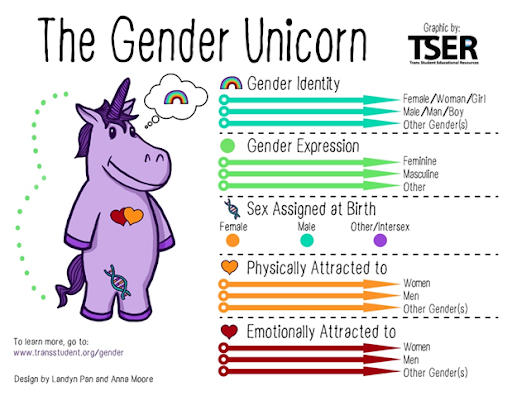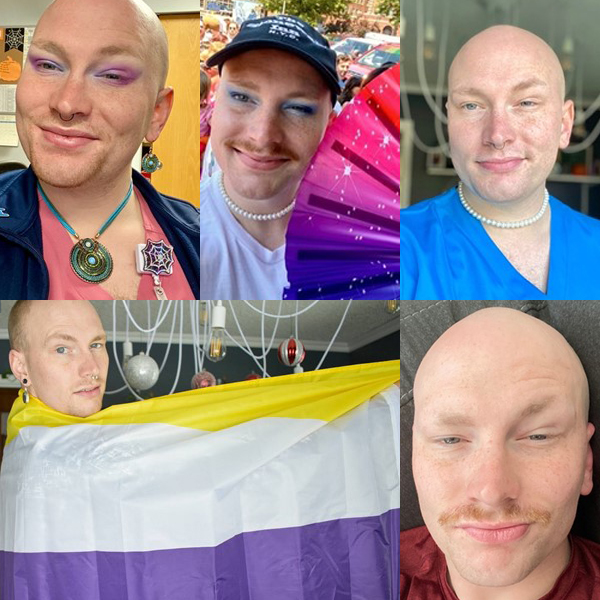Let me introduce myself
My name is Benjamin Lindsay, and I use the pronouns they/them. I am a masters-prepared nurse educator in the medical intensive care unit (MICU) of a large academic medical center in upstate New York. I grew up on a hobby goat farm in central New York. In that rural area, I did not find the diversity, equity and inclusion I desperately needed. I yearned for visibility, to be seen for how I felt on the inside. Instead, I was taught to reject the feminine parts of myself. I relocated for nursing school and joined Lambda, a pride organization. I will never forget attending Pride meetings in college. They expanded my horizons and provided a safe space to be myself.
The COVID-19 pandemic created a period of duality for me. On the one hand, I worked as many shifts as I felt my body, mind and spirit could handle. On the other, as a single individual, the quiet solitude outside of work provided a cocoon-like atmosphere where I marinated on who I am. I stopped identifying as male. In the early months of 2020, I first shared that I am nonbinary and began using they/them pronouns. When I openly came out, I emerged from my cocoon as a beautiful transgender nonbinary butterfly. When I came out as nonbinary on social media, I posted this image.

What is gender identity?
Gender identity is how an individual identifies their gender based on how they feel inside. An individual's gender identity may differ from the sex they were assigned at birth.
I describe my gender identity as transgender and nonbinary. Transgender means an individual's gender identity differs from the sex they were assigned at birth. Nonbinary means an individual does not feel their gender identity fits in either the binary of man or woman. Thus, my gender identity differs from the gender I was assigned at birth (male), and I do not feel like either a man or a woman.

The Gender Unicorn from transstudent.org helps me and may help you understand the following terms:
- Sex - An individual's biological status typically assigned at birth and based on external anatomy (male, female, intersex)
- Gender expression - How an individual represents their gender outwardly through behavior, clothing, voice and other characteristics. Gender expression is typically categorized as masculine or feminine.
- Intersex - A term used to describe an individual who was born with reproductive anatomy, chromosomes or hormones that don't fit in the typical categories of man or woman
- Gender dysphoria - The psychological distress an individual feels from the difference in the sex they were assigned at birth and their gender identity
My sex, which refers to my biological status, is male. It is important to me that my healthcare providers know my sex is male so that they can tailor their care to a male body.
My gender expression veers toward masculine on some days and feminine on other days. When I determined that I was nonbinary, I felt the freedom to live in the space between. Some days I enjoy a beautiful set of dangling earrings and a pearl necklace; however, some days I rock a goatee with no jewelry. I had gender dysphoria before coming out as nonbinary. I was often depressed, felt anxiety and was less happy than now. When I came out, I felt a huge relief. I could breathe again.
How might someone describe their gender identity?
Patients may use other terms to describe their gender identity. Before reviewing the definitions, I want to make clear that the following is not an exhaustive list.
- Transgender or trans - A term used to describe an individual whose gender identity differs from the sex they were assigned at birth
- Cisgender or cis - A term used to describe an individual whose gender identity matches their sex assigned at birth
- Nonbinary - A term used to describe an individual who does not feel their gender identity fits in either the binary of man or woman
- Agender - A term used to describe an individual who does not identify with a gender
- Gender expansive - A term used to describe an individual who identifies their gender with more flexibility than the typical binary
- Gender-fluid - A term used to describe an individual with no fixed gender identity
Gender identity does not equal a person's pronouns, and a person's pronouns do not equal their gender identity. You may think, "Since Benjamin is nonbinary, they use they/them pronouns." But that isn't necessarily true. The only way to be sure of the terminology and pronouns someone uses is to ask. Asking about a person's pronouns shows respect and caring.
Let's talk about gender expression
For me, gender expression shifts radically from masculine to feminine day-to-day. Some days my visible gender expression looks like a full face of makeup; other days I don't feel like shaving, so I sport a mustache and don't wear jewelry. See the spectrum of gender expression I exhibit:

Another key point here: Gender expression does not equal a person's gender identity, and a person's gender identity does not equal someone's gender expression.
How do I know someone's pronouns?
The best way to know an individual's pronouns is to ask. Pronouns affirm someone's gender, and asking makes them feel safe.
In the workplace, the Human Rights Campaign Foundation offers several recommendations on how to introduce pronouns during conversations with colleagues:
- During onboarding, create a place to ask new staff members' names and pronouns. Use their self-identified name and pronouns when introducing new hires to their colleagues. For example, "Everyone, I am pleased to introduce Benjamin Lindsay, who is transferring from the MICU. They will be the lead person on the new product development project."
- Consider using pronouns during introductions at meetings. For example, "We're going to go around the room to introduce ourselves. Please say your name, the unit that you work in and, if you want, your personal pronouns." "My name is Benjamin Lindsay. I work in the MICU. My pronouns are they, them, theirs."
The University of Texas at Arlington suggests first introducing yourself with your pronouns and then asking the patient's pronouns with an open-ended question. For example, "Hello, my name is Benjamin, your night-shift nurse, and my pronouns are they/them. How may I address you?"
Over the past couple of years, pronouns have become more visibly displayed. Visibly displaying pronouns is a way to signal your environment is a safe and inclusive space for all. At my workplace, we've been offered pronoun badge backers and progress flags to wear.
More resources on how to foster inclusivity in your healthcare facility are available from the Human Rights Campaign Foundation and the Society for Human Resources Management.
To me, it is important to share my pronouns and know those of others. You can share your pronouns in many ways, such as wearing a pin or sticker on your work badge. Include your pronouns in your email signature line. In many EMR systems, you can enter a patient's pronouns by their name. By sharing your pronouns, you reassure others that it is safe and you encourage them to share theirs.
There's so much to know. What if I screw up?
Ask questions.
Asking questions demonstrates a desire to understand me better. I never take offense when someone asks me questions as long as it comes from a place of respect. Pronoun mistakes do not insult me if I feel that person is trying. I proudly share my pronouns, because it's important that others use them when addressing me.
Proud, loud and authentically me
I live proud, loud and authentically. I am proud to be me and share my gender identity with the world and the American Association of Critical-Care Nurses.
I recognize that I am privileged to be of white appearance and live in a diverse and accepting city where I feel safe to be visibly queer and free with my gender expression. I recognize that others may not be in the same position to live or express their authentic selves.
I hope you'll consider these gender concepts when interacting with colleagues, patients and families. Recognize that not everyone feels safe or supported when sharing their gender identity. Think about how you can support others. Together, we can make a difference.
As a healthcare professional, how can you expand your knowledge on gender identity and LGBTQIA2s+ individuals?

Are you sure you want to delete this Comment?